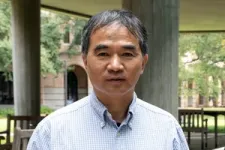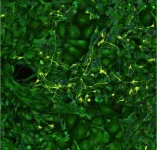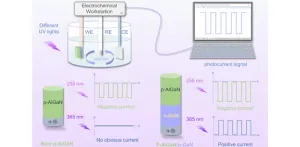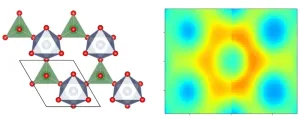(Press-News.org) It looks like a black hole and bends light like a black hole, but it could actually be a new type of star.
Though the mysterious object is a hypothetical mathematical construction, new simulations by Johns Hopkins researchers suggest there could be other celestial bodies in space hiding from even the best telescopes on Earth. The findings are set to publish in Physical Review D.
“We were very surprised,” said Pierre Heidmann, a Johns Hopkins University physicist who led the study. “The object looks identical to a black hole, but there’s light coming out from its dark spot.”
The detection of gravitational waves in 2015 rocked the world of astrophysics because it confirmed the existence of black holes. Inspired by those findings, the Johns Hopkins team set out to explore the possibility of other objects that could produce similar gravitational effects but that could be passing as black holes when observed with ultraprecise sensors on Earth, said co-author and Johns Hopkins physicist Ibrahima Bah.
“How would you tell when you don't have a black hole? We don't have a good way to test that,” Bah said. “Studying hypothetical objects like topological solitons will help us figure that out as well.”
The new simulations realistically depict an object the Johns Hopkins team calls a topological soliton. The simulations show an object looking like a blurry photo of a black hole from afar but like something else entirely up close.
The object is hypothetical at this stage. But the fact that the team could construct it using mathematical equations and show what it looks like with simulations suggests there could be other types of celestial bodies in space hiding from even the best telescopes on Earth.
The findings show how the topological soliton distorts space exactly as a black hole does—but behaves unlike a black hole as it scrambles and releases weak light rays that would not escape the strong gravitational force of a true hole.
“Light is strongly bent, but instead of being absorbed like it would in a black hole, it scatters in funky motions until at one point it comes back to you in a chaotic manner,” Heidmann said. “You don’t see a dark spot. You see a lot of blur, which means light is orbiting like crazy around this weird object.”
A black hole’s gravitational field is so intense that light can orbit around it at a certain distance from its center, in the same way that Earth orbits the sun. This distance determines the edge of the hole’s “shadow,” so that any incoming light will fatally hit the region that scientists call the “event horizon.” There, nothing can escape—not even light.
The Hopkins team simulated several scenarios using pictures of outer space as if they had been captured with a camera, placing a black hole and the topological soliton in front of the lens. The results produced distorted pictures because of the gravitational effects of the massive bodies.
“These are the first simulations of astrophysically relevant string theory objects, since we can actually characterize the differences between a topological soliton and a black hole as if an observer was seeing them in the sky,” Heidmann said.
Motivated by various results from string theory, Bah and Heidmann discovered ways to construct topological solitons using Einstein’s theory of general relativity in 2021. While the solitons are not predictions of new objects, they serve as the best models of what new quantum gravity objects could look like compared to black holes.
Scientists have previously created models of boson stars, gravastars, and other hypothetical objects that could exert similar gravitational effects with exotic forms of matter. But the new research accounts for pillar theories of the inner workings of the universe that other models don’t. It uses string theory that reconciles quantum mechanics and Einstein’s theory of gravity, the researchers said.
“It’s the start of a wonderful research program,” Bah said. “We hope in the future to be able to genuinely propose new types of ultracompact stars consisting of new kinds of matter from quantum gravity.”
The team includes Johns Hopkins physicist Emanuele Berti. The topological soliton in the simulations was first constructed in research published in 2022 by Bah’s group.
END
Could this copycat black hole be a new type of star?
2023-04-18
ELSE PRESS RELEASES FROM THIS DATE:
Exercise boosts brain health with chemical signals
2023-04-18
Physical activity is frequently cited as a means of improving physical and mental health. Researchers at the Beckman Institute for Advanced Science and Technology have shown that it may also improve brain health more directly. They studied how the chemical signals released by exercising muscles promote neuronal development in the brain.
Their work appears in the journal Neuroscience.
When muscles contract during exercise, like a bicep working to lift a heavy weight, they release a variety of compounds into the bloodstream. These compounds can travel to different parts of the body, including the brain. The researchers were particularly interested in how exercise could ...
Who goes to the ICU and why?
2023-04-18
More is not always better when it comes to hospital care. The same interventions that could save one patient’s life could lead to no benefit, higher hospital bills and even injury for another.
A University of Michigan led study published in the journal Intensive Care Medicine interviewed almost 90 clinicians and hospital staff and performed onsite observations across eight unaffiliated hospitals in Michigan to understand why different hospitals used the intensive care unit more than others.
“You would ...
New self-powered ultraviolet photodetector
2023-04-18
Ultraviolet (UV) light detection can revolutionize industries such as civil engineering, military defense, aerospace exploration, and medical research. The future of electronics relies heavily on energy-efficient devices that can function independently, which makes the development of photoelectric UV detectors critical. These detectors come in two main types: photoconductive and photovoltaic, each with unique advantages and applications.
Photoconductive detectors rely on the changes in the conductivity ...
People with severe obesity and a genetic pathway variant have increased risk of hypertension, Mayo Clinic research finds
2023-04-18
ROCHESTER, Minn. — Obesity and its associated cardiometabolic issues are a major health concern in the U.S. and internationally. According to a study published in 2017, 12% of the world's adult population was affected by obesity in 2016, double the percentage from 30 years earlier.
With obesity comes an increasing risk of cardiovascular disease, including stroke, congestive heart failure and myocardial infarction. Fortunately, obesity is a multifactorial disease that results from an energy balance dysregulation and often is a modifiable risk factor for cardiovascular disease.
"Body ...
Physicists find unusual waves in nickel-based magnet
2023-04-18
HOUSTON – (April 18, 2023) – Perturbing electron spins in a magnet usually results in excitations called “spin waves” that ripple through the magnet like waves on a pond that’s been struck by a pebble. In a new study, Rice University physicists and their collaborators have discovered dramatically different excitations called “spin excitons” that can also “ripple” through a nickel-based magnet as a coherent wave.
In a study published in Nature Communications, ...
Sex after menopause doesn’t need to hurt
2023-04-18
Between 13% and 84% of postmenopausal women experience vaginal pain during sex
Causes of pain other than vaginal dryness are often undiagnosed and untreated
Pain during sex can harm relationships, self-esteem and contribute to depression, anxiety
Safe, effective therapies exist but condition is rarely evaluated or treated
CHICAGO --- Between 13% and 84% of postmenopausal women experience dyspareunia—vaginal pain during sex—but the condition is rarely evaluated or treated despite the availability of safe and effective therapies. With life expectancy increasing and the functional health of older adults improving, ...
Public lecture: My career in five equations, and the importance of mathematics education in the digital age
2023-04-18
Professor Stephen Garrett to discuss why the UK needs to up its game in maths education
He has a particular interest in the development of mathematical and computational solutions to real-world problems
Lecture will take place on Thursday 27 April at Aston University.
18 April 2023 | Birmingham, UK
The latest inaugural lecture at Aston University is to explore why the UK’s low level of mathematical skills don’t add up to a positive digital future.
Professor Stephen Garrett will discuss why school-level mathematics is so important in many areas of life and will discuss how ...
Mouse study hints at specific brain receptor behind PCOS symptoms
2023-04-18
Polycystic ovarian syndrome, or PCOS, can cause a range of symptoms, including disrupted menstrual cycles, abdominal obesity, cardiovascular disease, and type 2 diabetes. It’s also one of the biggest causes of infertility — in fact, many people don’t discover they have the condition until they try to become pregnant.
One of the hallmarks of PCOS are elevated levels of hormones produced by the ovaries called androgens. Androgens play important roles in puberty and reproduction in people with ovaries and people with testes.
Researchers are trying to understand why PCOS develops and how androgens lead to negative symptoms. A recent study led by Alexandra ...
Epic sepsis model’s ability to predict depends on hospital factors
2023-04-18
In the fight against sepsis, one of the leading causes of death in hospitalized patients, clinicians are increasingly reliant on prediction tools trained on massive amounts of data stored in electronic health records. One of the most popular tools comes from Epic Systems and is used in more than half of United States hospitals. However, research has shown that its performance varies depending on the hospital in which it’s being used.
In a recent research letter published in JAMA Internal Medicine, researchers from U-M, Oregon Health and Sciences University, and Washington University looked for a possible explanation for this variation. Using more than 800,000 ...
Could fixing a problem with the heart be good for your brain?
2023-04-18
EMBARGOED FOR RELEASE UNTIL 4 P.M. ET, TUESDAY, APRIL 18, 2023
MINNEAPOLIS – People who have an irregular heartbeat called atrial fibrillation that is treated with a procedure called catheter ablation may have a reduced risk of dementia compared to those who are treated with medication alone. The preliminary study released April 18, 2023, will be presented at the American Academy of Neurology’s 75th Annual Meeting being held in person in Boston and live online from April 22-27, 2023.
Catheter ablation uses radiofrequency through a tube into the heart to destroy small areas of heart tissue that may be causing the abnormal heartbeat.
“Previous studies have ...




